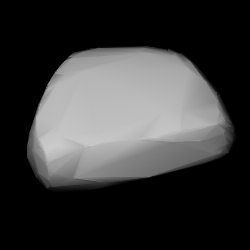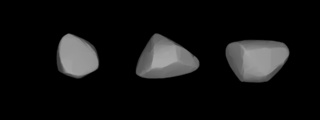Related Research Articles

2829 Bobhope is a dark asteroid of the Meliboea family, from the outer region of the asteroid belt. It was discovered on 9 August 1948, by South African astronomer Ernest Leonard Johnson at Union Observatory in Johannesburg. The asteroid was later named after comedian Bob Hope. The asteroid has a rotation period of 6.1 hours and measures approximately 37 kilometers in diameter.
1575 Winifred, provisional designation 1950 HH, is a stony Phocaea asteroid and slow rotator from the inner regions of the asteroid belt, approximately 9.5 kilometers in diameter.
1763 Williams, provisional designation 1953 TN2, is a stony Florian asteroid from the inner regions of the asteroid belt, approximately 7 kilometers in diameter. It was discovered on 13 October 1953, by astronomers of the Indiana Asteroid Program at Goethe Link Observatory in Indiana, United States. The asteroid was named after Kenneth P. Williams, professor of mathematics at Indiana University.
Lagrangea, provisional designation 1923 OU, is a carbonaceous background asteroid from the outer region of the asteroid belt, approximately 30 kilometers in diameter. It was discovered on 12 September 1923, by Russian astronomer Sergey Belyavsky at the Simeiz Observatory on the Crimean peninsula. The asteroid was named after Italian mathematician and astronomer Joseph-Louis Lagrange.

4492 Debussy is a dark and elongated background asteroid and binary system from the intermediate asteroid belt, approximately 15 kilometers in diameter. It was discovered on 17 September 1988, by Belgian astronomer Eric Elst at Haute-Provence Observatory in France. It was later named after French composer Claude Debussy.
1047 Geisha, provisional designation 1924 TE, is a stony Florian asteroid from the inner regions of the asteroid belt, approximately 11 kilometers in diameter. It was discovered on 17 November 1924, by German astronomer Karl Reinmuth at the Heidelberg-Königstuhl State Observatory in southwest Germany. The asteroid was named after the British musical The Geisha.
1096 Reunerta, provisional designation 1928 OB, is an asteroid from the background population of the asteroid belt's central region, approximately 40 kilometers in diameter. It was discovered on 21 July 1928, by astronomer Harry Edwin Wood at the Union Observatory in Johannesburg, South Africa. The asteroid was named after South African engineer Theodore Reunert, supporter of the observatory and friend of the discoverer.
1151 Ithaka, provisional designation 1929 RK, is a carbonaceous asteroid from the inner regions of the asteroid belt, approximately 14 kilometers in diameter. It was discovered by Karl Reinmuth at the Heidelberg-Königstuhl State Observatory in 1929, and later named for the Greek island of Ithaca.
6398 Timhunter, provisional designation 1991 CD1, is a stony Phocaea asteroid from the inner regions of the asteroid belt, approximately 5.5 kilometers in diameter. It was discovered on 10 February 1991, by American astronomer couple Carolyn and Eugene Shoemaker, in collaboration with Canadian astronomer David H. Levy at Palomar Observatory in California, United States. It was named for American amateur astronomer Tim Hunter.
1617 Alschmitt, provisional designation 1952 FB, is an assumed carbonaceous asteroid from in the outer parts of the main belt, approximately 30 kilometers in diameter. It was discovered on 20 March 1952, by French astronomer Louis Boyer at Algiers Observatory in Algeria, Northern Africa, and named after French astronomer Alfred Schmitt.
11277 Ballard, provisional designation 1988 TW2, is a Phocaea asteroid from the inner regions of the asteroid belt, approximately 6.3 kilometers (3.9 miles) in diameter. It was discovered on 8 October 1988, by American astronomer couple Carolyn and Eugene Shoemaker at the Palomar Observatory in California. The assumed S-type asteroid has a rotation period of at least 10 hours. It was named for American marine scientist Robert Ballard.
1354 Botha, provisional designation 1935 GK, is an exceptionally dark background asteroid from the outer regions of the asteroid belt, approximately 46 kilometers in diameter. It was discovered on 3 April 1935, by South-African astronomer Cyril Jackson at the Union Observatory in Johannesburg. The asteroid was named after South African prime minister Louis Botha.
3841 Dicicco, provisional designation 1983 VG7, is a stony Florian asteroid and synchronous binary system from the inner regions of the asteroid belt, approximately 5 kilometers in diameter. It was discovered on 4 November 1983, by American astronomer Brian Skiff at Lowell's Anderson Mesa Station near Flagstaff, Arizona, in the United States. It was named after American astronomer Dennis di Cicco. Its minor-planet moon, provisionally designated S/2014 (3841) 1, was discovered in 2014.
1303 Luthera, provisional designation 1928 FP, is a dark asteroid and the parent body of the Luthera family, located in the outermost regions of the asteroid belt. It measures approximately 90 kilometers in diameter. The asteroid was discovered on 16 March 1928, by astronomer Friedrich Schwassmann at the Bergedorf Observatory in Hamburg, Germany, and later named after German astronomer Robert Luther.
1300 Marcelle, provisional designation 1934 CL, is a carbonaceous asteroid from the middle region of the asteroid belt, approximately 30 kilometers in diameter. It was discovered on 10 February 1934, by French astronomer Guy Reiss at the North African Algiers Observatory in Algeria.
1376 Michelle, provisional designation 1935 UH, is a stony Florian asteroid from the inner regions of the asteroid belt, approximately 8 kilometers in diameter. It was discovered on 29 October 1935, by French astronomer Guy Reiss at the North African Algiers Observatory in Algeria. It is named for the discoverer's daughter, Michelle Reiss.

1444 Pannonia is a carbonaceous background asteroid from the outer region of the asteroid belt, approximately 29 kilometers in diameter. It was discovered on 6 January 1938, by Hungarian astronomer György Kulin at Konkoly Observatory in Budapest, Hungary. It was named after the ancient province of the Roman Empire, Pannonia.

1518 Rovaniemi, provisional designation 1938 UA, is a stony Florian asteroid from the inner regions of the asteroid belt, approximately 8 kilometers in diameter. Discovered by Yrjö Väisälä at the Turku Observatory in 1938, the asteroid was later named after the Finnish city of Rovaniemi.
2391 Tomita, provisional designation 1957 AA, is a Nysian asteroid from the inner regions of the asteroid belt, approximately 15 kilometers in diameter. The asteroid was discovered on 9 January 1957, by German astronomer Karl Reinmuth at Heidelberg Observatory in southern Germany. It was named after Japanese astronomer Kōichirō Tomita.
1775 Zimmerwald, provisional designation 1969 JA, is a stony Eunomian asteroid and slow rotator from the middle region of the asteroid belt, approximately 10 kilometers in diameter. It was discovered on 13 May 1969, by Swiss astronomer Paul Wild at Zimmerwald Observatory near Bern, Switzerland. It is named for the village of Zimmerwald, where the discovering observatory is located.
References
- 1 2 3 4 5 6 "1313 Berna (1933 QG)". Minor Planet Center. Retrieved 11 December 2018.
- 1 2 3 Schmadel, Lutz D. (2007). "(1313) Berna". Dictionary of Minor Planet Names – (1313) Berna. Springer Berlin Heidelberg. p. 107. doi:10.1007/978-3-540-29925-7_1314. ISBN 978-3-540-00238-3.
- 1 2 3 4 "JPL Small-Body Database Browser: 1313 Berna (1933 QG)" (2018-05-23 last obs.). Jet Propulsion Laboratory . Retrieved 11 December 2018.
- 1 2 "Asteroid 1313 Berna". Small Bodies Data Ferret. Retrieved 11 December 2018.
- 1 2 "Asteroid (1313) Berna – Proper elements". AstDyS-2, Asteroids – Dynamic Site. Retrieved 11 December 2018.
- 1 2 3 4 Masiero, Joseph R.; Mainzer, A. K.; Grav, T.; Bauer, J. M.; Cutri, R. M.; Nugent, C.; et al. (November 2012). "Preliminary Analysis of WISE/NEOWISE 3-Band Cryogenic and Post-cryogenic Observations of Main Belt Asteroids". The Astrophysical Journal Letters. 759 (1): 5. arXiv: 1209.5794 . Bibcode:2012ApJ...759L...8M. doi:10.1088/2041-8205/759/1/L8. S2CID 46350317.
- 1 2 3 Mainzer, A. K.; Bauer, J. M.; Cutri, R. M.; Grav, T.; Kramer, E. A.; Masiero, J. R.; et al. (June 2016). "NEOWISE Diameters and Albedos V1.0". NASA Planetary Data System: EAR-A-COMPIL-5-NEOWISEDIAM-V1.0. Bibcode:2016PDSS..247.....M . Retrieved 11 December 2018.
- 1 2 3 Masiero, Joseph R.; Mainzer, A. K.; Grav, T.; Bauer, J. M.; Cutri, R. M.; Dailey, J.; et al. (November 2011). "Main Belt Asteroids with WISE/NEOWISE. I. Preliminary Albedos and Diameters". The Astrophysical Journal. 741 (2): 20. arXiv: 1109.4096 . Bibcode:2011ApJ...741...68M. doi:10.1088/0004-637X/741/2/68. S2CID 118745497.
- 1 2 3 4 Mainzer, A.; Grav, T.; Masiero, J.; Hand, E.; Bauer, J.; Tholen, D.; et al. (November 2011). "NEOWISE Studies of Spectrophotometrically Classified Asteroids: Preliminary Results". The Astrophysical Journal. 741 (2): 25. arXiv: 1109.6407 . Bibcode:2011ApJ...741...90M. doi:10.1088/0004-637X/741/2/90. S2CID 35447010. (catalog)
- 1 2 3 Carry, B. (December 2012). "Density of asteroids". Planetary and Space Science. 73 (1): 98–118. arXiv: 1203.4336 . Bibcode:2012P&SS...73...98C. doi:10.1016/j.pss.2012.03.009. S2CID 119226456.
- 1 2 3 4 Usui, Fumihiko; Kuroda, Daisuke; Müller, Thomas G.; Hasegawa, Sunao; Ishiguro, Masateru; Ootsubo, Takafumi; et al. (October 2011). "Asteroid Catalog Using Akari: AKARI/IRC Mid-Infrared Asteroid Survey". Publications of the Astronomical Society of Japan. 63 (5): 1117–1138. Bibcode:2011PASJ...63.1117U. doi: 10.1093/pasj/63.5.1117 . (online, AcuA catalog p. 153)
- 1 2 3 4 Nugent, C. R.; Mainzer, A.; Bauer, J.; Cutri, R. M.; Kramer, E. A.; Grav, T.; et al. (September 2016). "NEOWISE Reactivation Mission Year Two: Asteroid Diameters and Albedos". The Astronomical Journal. 152 (3): 12. arXiv: 1606.08923 . Bibcode:2016AJ....152...63N. doi: 10.3847/0004-6256/152/3/63 .
- 1 2 3 4 5 6 "LCDB Data for (1313) Berna". Asteroid Lightcurve Database (LCDB). Retrieved 16 January 2017.
- 1 2 3 Behrend, R.; Roy, R.; Sposetti, S.; Waelchli, N.; Pray, D.; Berger, N.; et al. (February 2004). "(1313) Berna". IAU Circ. 8292 (8292): 3. Bibcode:2004IAUC.8292....3B.
- 1 2 Behrend, R.; Bernasconi, L.; Roy, R.; Klotz, A.; Colas, F.; Antonini, P.; et al. (February 2006). "Four new binary minor planets: (854) Frostia, (1089) Tama, (1313) Berna, (4492) Debussy" (PDF). Astronomy and Astrophysics. 446 (3): 1177–1184. Bibcode:2006A&A...446.1177B. doi: 10.1051/0004-6361:20053709 . Retrieved 16 January 2017.
- 1 2 Behrend, Raoul. "Asteroids and comets rotation curves – (1313) Berna". Geneva Observatory. Retrieved 16 January 2017.
- 1 2 3 4 5 Marchis, F.; Enriquez, J. E.; Emery, J. P.; Mueller, M.; Baek, M.; Pollock, J.; et al. (November 2012). "Multiple asteroid systems: Dimensions and thermal properties from Spitzer Space Telescope and ground-based observations". Icarus. 221 (2): 1130–1161. arXiv: 1604.05384 . Bibcode:2012Icar..221.1130M. doi:10.1016/j.icarus.2012.09.013. S2CID 161887.
- ↑ Johnston, Robert. "(131) Berna". johnstonsarchive.net. Retrieved 28 May 2015.
- ↑ Wm. Robert Johnston (1 November 2015). "Asteroids with Satellites". Johnston's Archive. Retrieved 24 November 2015.